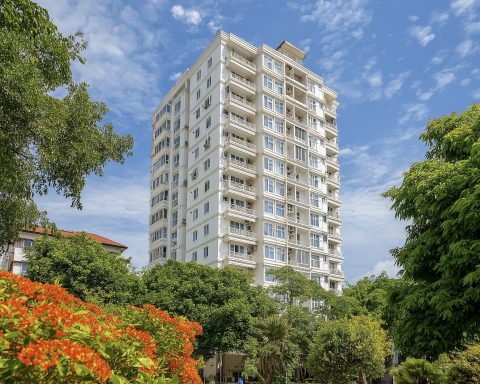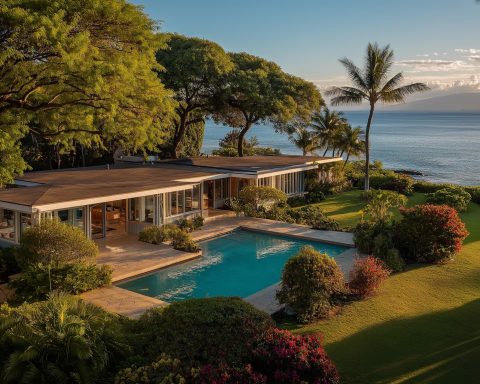- North America (USA): U.S. housing stuck near historic lows as 6–7% mortgage rates choke demand – home sales flat at ~4.0 million annualized, with experts warning of a possible price correction ahead nar.realtor reuters.com.
- Europe: UK house prices dip year-over-year for the first time since 2024 amid tax hike jitters reuters.com, while rents see their slowest rise in 4 years reuters.com. Investors pivot financing strategies as Blackstone launches a £2 billion lending push to fill Europe’s property credit gap recapitalnews.com.
- Asia-Pacific: China’s property slump deepens – new home prices fell 2.5% annually despite policy easing reuters.com reuters.com; analysts say a true housing turnaround won’t come until 2026 or later reuters.com. Yet signs of life emerge: Singapore’s Centurion Accommodation REIT IPO raises S$771 million and pops +11% on debut reuters.com, signaling renewed investor appetite in Asian real estate.
- Latin America: Sky-high interest rates bite: Brazil’s benchmark rate near 15% makes risk-free bonds (13–14% yields) more attractive than property, stalling new developments amimarinternational.com. In Mexico, the U.S. tariff threat has put a “pause — not a cancellation — in investment plans” for booming industrial parks amimarinternational.com, damping the nearshoring real estate wave.
- Middle East: Dubai’s property boom accelerates – Q2 sales hit AED 153.7 billion (≈$42B), up 44.5% YoY, as off-plan deals surge from global investor demand khaleejtimes.com. With 32,000+ units under construction and flexible payment plans, the emirate is cementing its status as a “global safe-haven” for real estate investment khaleejtimes.com.
- Africa & Land Markets: Resilient outlook: Africa’s youthful demographics and reforms are driving strong real estate fundamentals, with no crash in sight indepthresearch.org. In Argentina, a battle brews over the “Ley de Tierras” rural land law – foreign buyers remain capped to 15% of farmland nationally gatewaytosouthamerica-newsblog.com after a repeal by the new government was frozen by the courts gatewaytosouthamerica-newsblog.com, keeping sovereignty-focused land limits in force.
Global Real Estate Roundup (Sept 25–26, 2025)
North America: Housing Rut Continues, Glimmers in Commercial
America’s housing market remains in a tight vise of high interest rates and low inventory. The National Association of Realtors reports existing-home sales are essentially flat – down just 0.2% in August to a 4.0 million annual rate nar.realtor. “Home sales have been sluggish due to elevated mortgage rates and limited inventory,” says NAR Chief Economist Lawrence Yun, noting that recent easing in rates and a rise in listings “should boost sales in the coming months.” nar.realtor Still, buying a home is far out of reach for many first-timers. James Knightley, chief economist at ING, warns that with a softening labor market, “housing demand will remain soft… we could start to see some forced sellers… if unemployment rises,” potentially causing a modest house price correction within 6–12 months reuters.com. Median U.S. home prices are up only ~2% this year, and analysts expect only ~1% growth in 2026 – a stark downshift from the pandemic boom reuters.com.
High mortgage rates (~6.5–7%) are sapping affordability, keeping many would-be buyers sidelined reuters.com. Current homeowners cling to their sub-4% mortgages, so fresh listings are scarce. On the bright side, inventory has inched up to its highest level of the decade, offering a bit more choice to buyers reuters.com. And if the Federal Reserve proceeds with anticipated rate cuts into 2026 reuters.com ubs.com, mortgage costs could ease slightly – though experts caution any relief will be “marginal” given long-term rates remain elevated reuters.com.
Commercial and industrial real estate in North America is navigating a hesitant recovery. A new Savills report finds sentiment is improving – roughly $380 billion poured into global real estate in H1 2025 marketsgroup.org, and in Q2 the U.S. led a surprising jump in office deals, with volumes up 50% year-on-year (albeit from a low base) marketsgroup.org. Reservations about offices are easing as limited new construction has kept supply in check and driven up office rents in some cities marketsgroup.org. Even so, the work-from-home overhang remains; downtown vacancies are high and older offices are being repriced. The bright spots are sectors like industrial warehouses and senior housing – logistics properties held steady with ~$86B in H1 transactions marketsgroup.org, and investment in senior living surged 80% year-to-date as investors bet on aging demographics marketsgroup.org.
Meanwhile, a noteworthy drama is unfolding on Wall Street: FINRA, the U.S. market watchdog, is probing possible insider trading around a failed takeover bid for luxury brokerage Douglas Elliman. The review seeks to learn who knew about rival Anywhere Real Estate’s offer – which sent Elliman’s stock soaring 50% on rumor – “before it became public” in May reuters.com. The investigation underscores intense interest in U.S. real estate firms, even as the brokerage business grapples with slower sales and consolidation. (Anywhere – parent of brands like Coldwell Banker – had itself been weighing acquisitions as traditional firms adjust to the cooling market.)
Europe: Cooling Housing Markets & Creative Financing
Europe’s property landscape in late 2025 is a tale of two trends – housing markets losing steam in some areas, while creative financing steps in to support the beleaguered commercial sector. In the UK, house prices have finally turned negative year-on-year. Real estate portal Rightmove’s data shows asking prices in early September were 0.1% lower than a year ago – the first annual decline since January 2024 reuters.com. Prices rose a meager +0.4% from the previous month, far below the usual autumn uptick reuters.com. “Rumours of property tax changes… and extended uncertainty can affect market activity, especially in the higher price brackets,” explains Colleen Babcock of Rightmove, noting that talk of new taxes (expected in the Nov 26 Budget) has hit sentiment at the top end reuters.com. The biggest drops are in London and southern England where prices were frothiest and potential tax hikes loom reuters.com.
On the rental side, Britain’s red-hot rents are finally cooling. Average rents in early September were up 2.4% from a year ago – the slowest annual rise in four years reuters.com. “Lower migration and better mortgage availability for first-time buyers are easing competition for rented homes,” says Richard Donnell of Zoopla reuters.com. With more flats hitting the market, renters have a bit more breathing room. Still, UK housing affordability remains stretched; it now takes roughly 10+ years of income to buy a median home in cities like London ubs.com, pushing policymakers to consider interventions. Indeed, analysts note many global cities are introducing “tougher rules, from new taxes to outright purchase bans to rent controls,” to rein in prices and protect local buyers ubs.com.
Europe’s commercial real estate sector faces a financing crunch – and big players are stepping in. As banks pull back amid higher interest rates, alternative lenders like private equity giant Blackstone are filling the void. Blackstone Real Estate Debt Strategies just announced a £2 billion partnership with lender Pluto Finance to fund small and mid-sized developers across the UK and EU recapitalnews.com. The venture will offer whole loans (£25–100M) over the next two years, targeting projects that might otherwise stall for lack of credit propertysoup.co.uk. This infusion aims to “expand [Blackstone’s] presence in mid-market property lending” and exploit opportunities as traditional lenders retreat propertysoup.co.uk. It comes as European real estate faces a widening “credit gap” – top-tier firms can still secure loans, but debt-laden and smaller developers are struggling m.fastbull.com. By supplying fresh capital, investors hope to prevent a deeper downturn and also capitalize on distressed valuations.
Across continental Europe, property markets are highly divergent. Germany’s housing market has cooled but not crashed, while Spain and Italy see modest growth. Notably, global “bubble risk” indices show formerly overheated cities like Frankfurt, Paris, and Amsterdam have deflated significantly from pandemic peaks ubs.com. UBS’s 2025 Real Estate Bubble Index puts Miami at the top risk globally, followed by Tokyo and Zurich, but ranks London, Paris, and Milan as low-risk, reflecting their recent price corrections ubs.com. In fact, many European cities flagged as bubble risks a few years ago have seen prices drop ~20% in real terms, versus ~5% drops in less inflated markets ubs.com. “Broad exuberance has faded,” says Matthias Holzhey of UBS, noting average bubble risk scores have fallen for a third straight year ubs.com. With the European Central Bank likely at or near peak rates and inflation easing, analysts foresee stability ahead – though any relief will be gradual. By 2026, central banks are expected to begin cutting rates, which “gradually lowers financing costs” and could reenergize buyer demand ubs.com. Until then, Europe’s real estate outlook is one of cautious hope, tempered by high financing costs and economic uncertainty.
Asia-Pacific: China’s Ongoing Slump, Bright Spots in SE Asia
In Asia, real estate news is dominated by China’s prolonged property downturn – and the government’s ongoing efforts to stop the slide. Fresh data in late September confirms China’s home prices are still falling: new home prices in August dropped 0.3% from July (the fourth straight monthly decline) and are down 2.5% year-on-year reuters.com reuters.com. Demand remains weak despite dozens of stimulus measures since 2022 – from mortgage rate cuts to eased homebuying curbs – none of which have yet restored buyer confidence reuters.com. “The real estate market is likely to face significant adjustment pressure in the near term,” warns Zhang Dawei, analyst at Centaline Property, who notes that most analysts now don’t expect prices to stabilize until late 2026 or 2027 reuters.com reuters.com. The sector’s plight is a huge drag on the wider economy, which relied on property for ~25% of activity in the boom years reuters.com. Property investment has plunged nearly 13% year-to-date reuters.com, and developers like Evergrande and Country Garden are teetering.
Beijing is responding with gradual but steady support. In recent weeks, megacities Shanghai and Shenzhen scrapped some home purchase restrictions to spur demand reuters.com. The central bank cut key rates and, in a significant shift, regulators told banks to allow existing mortgage holders to refinance at lower rates, effectively reducing payments for millions of households. Premier Li Qiang has called for “forceful measures to… stimulate demand for housing upgrades,” signaling that more easing – like cuts to the benchmark Loan Prime Rate or down-payment requirements – could be coming reuters.com. So far, these steps have only stabilized sentiment, not reversed it. But observers note that pent-up urban demand (from years of one-home policies) and huge savings pools in China could eventually re-enter the market if confidence returns. For now, however, China’s once-sizzling housing market remains in a buyer’s market correction, weighing on global commodities (steel, iron ore) and sparking deflation fears.
Beyond China, other Asian markets offer a contrast. Hong Kong – which closely tracks mainland fortunes – has seen its housing affordability worsen to the worst in the world (an average 60 m² flat costs 14 years of income for a skilled worker) ubs.com. In response, Hong Kong’s government just took a bold step banning ultra-tiny “subdivided” apartments that had proliferated as cheaper housing. Lawmakers passed new rules on Sept 25 setting 86 sq. ft. as the minimum flat size and requiring each unit have its own bathroom abcnews.go.com abcnews.go.com. This outlaws the notorious cage-home style flats and mandates landlords retrofit or lose their licenses. While aimed at improving living standards for the ~220,000 residents of such units abcnews.go.com, the policy could tighten near-term rental supply and has low-income tenants worried about evictions or rent hikes abcnews.go.com. Officials pledged to add 189,000 public housing units in five years to offset the changes abcnews.go.com. It’s a dramatic example of how Asia’s most expensive city is grappling with an affordability crisis – by raising standards even as prices remain sky-high.
Elsewhere in Asia-Pacific, positive news is emerging. Singapore is cementing its reputation as a financial hub for real estate investment. On Sept 25, Centurion Accommodation REIT – a trust owning dormitories and student housing – debuted on the SGX and surged 11% from its IPO price reuters.com. The IPO raised S$771 million (~$600M) – Singapore’s second-largest listing of the year reuters.com – and was seen as a bellwether for property trusts. “The successful REIT IPO… signals the return of REIT IPOs to the market,” said Tay Hwee Ling of Deloitte, adding that it “boosts sponsor confidence” to use Singapore’s exchange for unlocking real estate value reuters.com reuters.com. Indeed, after a drought, multiple REITs are now in the pipeline for listing, encouraged by new government incentives (like a 20% tax rebate for IPOs) reuters.com. Singapore’s ability to attract real estate capital contrasts with the struggles of Hong Kong’s exchange, and highlights how investors are selectively bullish on certain Asian markets.
India, too, offers a mixed but generally resilient picture. A new report by Anarock showed housing sales in India’s top 7 cities totaled ~97,000 units in Q3 2025 – down 9% from a year ago in volume, yet the total value of homes sold jumped 14% business-standard.com business-standard.com. The divergence is explained by a shift to high-end properties: luxury and ultra-luxury homes (₹1.5 crore and above) made up a record 38% of new launches, as developers target affluent buyers business-standard.com. Average prices are up ~9% YoY nationwide, with some cities like Delhi (NCR) spiking 24% business-standard.com. “The housing market remains steady in 2025, with expectations of a festive boost,” the report noted, as the upcoming Diwali season typically lifts sales business-standard.com. Anuj Puri, Anarock’s chairman, pointed out that while most cities saw sales dip this year, a couple of markets (Chennai, +33%, and Kolkata, +4%) bucked the trend business-standard.com – indicating uneven demand. India’s housing demand is underpinned by favorable demographics and urbanization, but constrained by rising mortgage rates and construction costs. Overall, the sentiment is cautiously optimistic: developers are launching slightly more units than last year business-standard.com, unsold inventory is inching down, and the market is absorbing new supply without trouble. With the central bank holding rates steady and inflation moderate, India’s property sector appears to be navigating a soft landing rather than a hard crash.
Latin America: High Rates and Uncertainties Test the Market
Latin American real estate is contending with steep financial and geopolitical headwinds as we enter the final quarter of 2025. Nowhere is this more evident than in Brazil, the region’s largest economy, where an ultra-tight monetary stance has created a “15% reality check” for property funding amimarinternational.com. Brazil’s Central Bank, after battling inflation, has kept its Selic interest rate at a towering ~15%, the highest in nearly two decades amimarinternational.com. This has dramatically raised borrowing costs for developers and homebuyers alike. Government bonds now yield around 13.7%, and bank deposits 12–14% amimarinternational.com – meaning investors can get double-digit, low-risk returns without touching real estate. Unsurprisingly, capital has flowed out of realty projects into these safer havens. The result is a funding crunch: Brazil’s once-vibrant real estate development pipeline has slowed to a trickle except for the most lucrative, “can’t-miss” projects. Commercial property yields simply can’t compete when your cost of capital is 14–15%, so many new offices or malls are economically unfeasible to build now amimarinternational.com. Even though commercial rents jumped ~8.5% over the past year in Brazil, discount rates remain sky-high, erasing those gains amimarinternational.com. As one industry observer quipped, why build apartments for a 7% yield when you can get 13% on a govvies (government bond) with zero hassle?
Brazilian policymakers are looking for creative solutions. The central bank has noted a sharp drop in savings deposits – traditionally the main source of mortgage lending – and is exploring “bridge solutions” to prop up real estate finance amimarinternational.com. This might include incentivizing new funding vehicles or even direct credit lines to the sector. Until rates come down materially (rate cuts are expected to start later in 2025), Brazil’s property market will likely tread water. On the ground, home prices in São Paulo and Rio have leveled off, and transaction volumes are subdued. Yet, there’s a sense that pent-up demand is building: once financing becomes affordable again, Latin America’s most populous nation could see a surge of activity. For now, though, patience is the name of the game.
North of the equator, Mexico’s real estate boom has been one of the region’s big stories – fueled by “nearshoring” (foreign manufacturers setting up plants to be close to the U.S. market). However, a cloud of uncertainty has recently parked over Mexico’s industrial property sector, emanating from trade policy rumblings. The U.S. has threatened to impose up to 25% tariffs on Mexican exports as part of renegotiation tactics, which is chilling business confidence. Although no such tariff has taken effect (current average tariff on Mexican goods is under 0.3%) amimarinternational.com, the mere threat has caused companies to hit pause on expansion plans. Roughly 70% of companies in Mexican industrial parks still plan to grow production, but many have delayed decisions on new factories or warehouses amimarinternational.com. “We’re seeing a pause – not a cancellation – in investment plans,” observes Sergio Argüelles, CEO of FINSA (a top industrial park developer) amimarinternational.com. This investment hesitation is evident in key manufacturing hubs: industrial lease signings have slowed and some warehouse vacancies ticked up for the first time in years. The nearshoring boom isn’t over by any means – Mexico still stands to gain as firms diversify from China – but it’s taking a breather. The IMF even revised Mexico’s 2025 GDP outlook to a -0.3% contraction (from +1.4% growth projected earlier), citing trade and policy uncertainties amimarinternational.com. That economic softness, plus high interest rates (~11.25% in Mexico), is a dual drag on real estate activity.
Elsewhere in Latin America, geopolitical and financial risks abound. Argentina has been an extreme case: battling 200% inflation and a currency freefall over 2022–23 amimarinternational.com, which have upended its property market (many listings shifted to dollar prices or crypto). However, a new reformist government under President Javier Milei took office vowing to liberalize the economy – including shaking up Argentina’s strict land ownership laws. Notably, Milei’s administration moved to repeal the 2011 “Ley de Tierras” – a law that strictly limits foreign ownership of rural land to protect national sovereignty gatewaytosouthamerica-newsblog.com. The law caps foreigners to 15% of all rural land nationwide (and only 1000 ha per person in key farming zones) gatewaytosouthamerica-newsblog.com. It also bars foreign purchases near water bodies or borders without special approval gatewaytosouthamerica-newsblog.com. Many investors saw the law as a barrier to agricultural investment; for example, billionaires like Italy’s Benetton family (owning 900k ha of Patagonian sheep ranches) had to navigate these rules gatewaytosouthamerica-newsblog.com. Milei’s push to abolish these limits was welcomed by agribusiness – but it hit a snag: Argentina’s Supreme Court froze the repeal by emergency decree, pending review gatewaytosouthamerica-newsblog.com. For now, the foreign farmland caps remain in force, keeping this aspect of the land market status quo. It’s a high-stakes debate between those who argue the law protects national patrimony and those who say Argentina desperately needs foreign capital to boost productivity. A final court ruling is expected in 2026.
Despite challenges, opportunities glimmer in Latin America. Some markets, like Uruguay, are seeing robust property growth amid regional stability – Montevideo’s housing market is buoyant, attracting international buyers seeking a safe haven. And across the region, from Colombia to Peru, younger populations and housing deficits mean fundamental demand is strong for affordable homes and modern logistics space. The key will be navigating the current storms: high interest rates, political shifts, and external economic pressures. If inflation moderates and global conditions improve, Latin American real estate stands ready to rebound thanks to its favorable demographics and abundant resource wealth.
Middle East: Gulf Real Estate Riding High
The Middle East’s real estate markets – particularly the Gulf region – are in a dynamic phase of rapid growth and strategic investment. Nowhere is this more apparent than in Dubai, which is in the midst of another property surge that’s defying global cooling trends. Dubai’s Land Department data for Q2 2025 showed record-shattering sales: AED 153.7 billion (~$42 billion) in property transactions, up 44.5% from Q2 2024 khaleejtimes.com khaleejtimes.com. This boom is being propelled largely by off-plan sales (new developments sold before construction) which now dominate the market khaleejtimes.com. Developers have ramped up launches of glitzy projects to meet insatiable demand from both local and international buyers.
What’s driving Dubai’s remarkable resilience? A few factors stand out:
- Investor-friendly policies: The UAE government has rolled out initiatives to attract foreign buyers – from easier residency visas for property investors to 100% foreign business ownership laws. These moves, coupled with stable rental yields and a reputation for safety, have solidified Dubai as a global investment haven.
- High-end and Luxury Demand: Wealthy buyers, including a growing influx of high-net-worth individuals (HNWIs) from Europe, Asia, and Africa, are snapping up Dubai real estate as a diversification play. Developers report luxury villas and beachfront penthouses often selling out within days of launch. “High-net-worth individuals continue to fuel demand for luxury off-plan homes,” local analysts note, while mid-market projects also gain traction with first-time buyers drawn by flexible payment plans khaleejtimes.com.
- Economic Vision: Dubai’s leadership has a clear Real Estate Strategy 2033 and broader “D33” economic agenda to double the economy. Part of this involves ensuring the property sector’s growth aligns with long-term goals. Massive infrastructure projects (new transport links, the Dubai Urban Master Plan) support real estate expansion. As one report put it, Dubai is positioning itself as a global safe-haven for property investment, and current trends reinforce that narrative khaleejtimes.com.
Indeed, developers are racing to keep up. Over 32,400 residential units are under construction in Dubai and Abu Dhabi combined khaleejtimes.com. Many offer innovative sales incentives – post-handover payment plans, crypto payment options, guaranteed rental returns – to entice buyers in a competitive market khaleejtimes.com. Notably, some of the world’s boldest architectural projects are rising in the Gulf: Saudi Arabia’s NEOM megacity and The Line, Kuwait’s Silk City, and various record-breaking skyscrapers in Dubai and Abu Dhabi. These headline-grabbing developments aim to transform regional skylines and diversify economies away from oil.
The Middle East is also exporting its real estate muscle overseas. Cross-border deals have picked up, such as a Middle Eastern consortium’s recent A$1.05 billion play for a portfolio of London housing eliteagent.com. Gulf sovereign wealth funds and royals are investing heavily from London to Manhattan, drawn by post-COVID price dips and long-term confidence in global gateway cities. This trend underscores how flush liquidity in the Middle East – thanks to high oil prices in recent years – is being funneled into property assets worldwide.
On the commercial side, Gulf commercial real estate (offices, malls, hotels) is likewise thriving. Abu Dhabi and Riyadh have seen office rents climb as corporations open regional HQs there. In Riyadh, demand for Grade A offices exceeds supply, mirroring the kingdom’s business boom under Vision 2030 reforms. The hospitality sector is booming too: Dubai’s hotel occupancy and room rates are near all-time highs, buoyed by tourism and mega-events, and Saudi Arabia is building entire new tourism cities (e.g. the Red Sea Project) from scratch. To sustain this growth, Gulf developers are tapping capital markets; for example, several REITs (Real Estate Investment Trusts) have listed on local stock exchanges, allowing investors to buy into rental portfolios. Regional REITs have performed well in 2025, aided by steady rental income and investor-friendly regulations.
Overall, the Middle East’s real estate scene in late 2025 is a striking counterpoint to the West. While higher interest rates have cooled U.S. and European markets, the Gulf – often with currencies pegged to the dollar – has so far brushed off rate concerns. Abundant liquidity, proactive governance, and genuine housing demand from population growth (especially in Saudi Arabia) create a potent mix for continued expansion. Analysts do advise some caution: affordability for local middle-class buyers is an emerging issue (Dubai’s home prices are up ~20% since 2020 and rents +25% YoY in some areas khaleejtimes.com). Governments are monitoring for any speculative excess. But compared to the last Dubai boom-bust cycle in 2009, today’s market is seen as more fundamentally driven. The coming months will test whether the Gulf can maintain its winning streak if global financial conditions tighten – for now, it’s full steam ahead in the desert sands.
Africa: Strong Fundamentals and Growth Potential
Across Africa, real estate markets are quietly entering 2025 with a sense of optimism and resilience. Despite global headwinds, major African economies are not showing signs of a property crash. In fact, a recent analysis highlights Africa’s strong real estate outlook, underpinned by rapid urbanization, population growth, and reforms indepthresearch.org. The continent’s population is set to exceed 1.5 billion by 2030, with a booming urban youth demographic indepthresearch.org. This translates to burgeoning demand for housing, offices, shopping centers, and industrial facilities virtually across the board. Unlike many aging developed markets, Africa’s youthful population ensures steady household formation and needs for new homes and workplaces.
Governments are also stepping up with policy support. Key countries – Kenya, Nigeria, South Africa, among others – are implementing reforms to unlock real estate investment indepthresearch.org. These include expanding mortgage availability (traditionally very low in Africa), modernizing land registries, and encouraging public-private partnerships to tackle housing shortages. For example, Kenya has rolled out an affordable housing program with incentives for developers, and Nigeria has been recapitalizing its Federal Mortgage Bank to extend more home loans. Such initiatives are aimed at reducing Africa’s well-documented housing deficit (estimated in the tens of millions of units continent-wide) and boosting investor confidence. Supportive government policies are boosting the sector, notes the Indepth Research Institute, which finds that these reforms, coupled with infrastructure investment, are key reasons Africa’s markets remain on “strong fundamentals” indepthresearch.org indepthresearch.org.
Investors – both local and foreign – are taking notice of Africa’s real estate opportunities. Some notable trends:
- Affordable Housing: There’s a big push in many cities to develop housing that’s within reach for middle-income and working-class families. Developers are innovating with cheaper construction tech (like prefab and modular homes) to bring unit costs down. Governments, in turn, often provide land or tax breaks for such projects. This segment not only addresses social needs but also promises volume – the demand is enormous.
- Commercial & Logistics Expansion: African cities are witnessing a rapid expansion of modern office parks, shopping malls, and industrial parks indepthresearch.org. For instance, Nairobi, Kenya and Kigali, Rwanda have new special economic zones; Ghana opened West Africa’s largest mall; and Egypt is developing a new administrative capital with vast office districts. Logistics hubs are also on the rise, fueled by growth in e-commerce and retail – companies need warehouses and distribution centers, which are springing up around ports and major highways.
- Tourism & Hospitality: From beachfront resorts in Zanzibar to safari lodges in Botswana, the hospitality real estate sector is growing, buoyed by rising tourism and business travel. Egypt’s real estate market, for example, is projected to reach $1.58 trillion by 2025, with homes leading but hotels and resorts also significant rprealtyplus.com.
- Mixed-Use Developments: City planners in Africa are increasingly embracing mixed-use projects – self-contained neighborhoods combining residential, retail, and office spaces. Think of developments like Eko Atlantic in Lagos or Tatu City in Nairobi. These help manage chaotic urban sprawl and create live-work-play environments attractive to a rising middle class.
To be sure, Africa’s property markets face challenges too. Financing remains a big hurdle – local interest rates are often high (double digits in many countries), making mortgages and development loans expensive. Construction costs can be elevated due to reliance on imported materials, and regulatory red tape can delay projects indepthresearch.org. Some countries have currency volatility that worries investors (e.g. Ghana’s cedi or Nigeria’s naira swings). Political instability or security issues in certain regions also pose risks. However, these challenges are gradually being addressed. For instance, local manufacturing of cement and building materials is improving, trade agreements like AfCFTA (African Continental Free Trade Area) may reduce costs, and digital tech (PropTech) is making processes like land titling more transparent indepthresearch.org.
Crucially, the consensus is that Africa’s real estate is built on real end-user demand, not speculation. “Unlike markets vulnerable to oversupply or speculative bubbles, Africa’s property sector is supported by genuine demand,” the Indepth report emphasizes indepthresearch.org. There is still far more need for quality housing and commercial space than supply in most African cities – a fundamentally different scenario from, say, parts of China or the West. This grounding in real demand provides a cushion against downturns. Even if global investors become risk-averse, local demand persists.
In summary, as 2025 approaches, Africa stands out as a region of untapped potential in real estate. International funds are increasingly exploring opportunities, from shopping center REITs in South Africa to new city developments in East Africa. Many savvy investors view Africa as a long-term play: get in early while prices are low and growth prospects high. With the right mix of continued reforms, infrastructure development, and stable governance, Africa could well be the next big real estate success story over the coming decade.
Forecast & Outlook: Looking ahead, global real estate experts are watching a few key factors. Interest rates top the list – by late 2025/early 2026, the expectation is that central banks from the U.S. Fed to the ECB will finally pivot to rate cuts as inflation cools reuters.com ubs.com. That could revive housing demand and investment worldwide, as financing becomes cheaper. However, any recovery might be slow; lenders burned by recent volatility may stay cautious, and in many places affordability will remain stretched even if rates dip slightly reuters.com. Another theme is regulation: from New York to Berlin to Beijing, policymakers are increasingly intervening in property markets (through rent controls, foreign buyer taxes, vacant home taxes, etc.) to address social concerns. These actions can significantly alter investment calculus. Lastly, the post-pandemic “new normal” in how people live and work is still shaking out. Will office occupancy ever return to pre-2020 levels? Can e-commerce demand keep warehouse construction buzzing? Will global travel fully rebound to fill hotels and short-term rentals? Early signs are mixed, but there’s optimism that the worst dislocations are over.
As this roundup shows, September 2025 finds global real estate at a crossroads: some markets are rebounding with vigor (Dubai, parts of the U.S. commercial sector), others are struggling and reinventing (China, UK, Latin America), and all are adapting to a high-rate environment. Investors and homebuyers alike are watching for turning points – and as always in real estate, remembering the adage: all markets are local. Even in a globalized economy, the fate of a condo in Miami or an office tower in Paris hinges on local jobs, policies, and people’s decisions on where to live and work. Stay tuned as we move into the final quarter of 2025; if interest rates indeed start to ease, 2026 could usher in a new chapter of opportunities across the world’s property markets.
Sources: Global news reports and expert analyses nar.realtor reuters.com reuters.com reuters.com recapitalnews.com reuters.com reuters.com reuters.com amimarinternational.com amimarinternational.com khaleejtimes.com khaleejtimes.com indepthresearch.org gatewaytosouthamerica-newsblog.com, as cited above.










